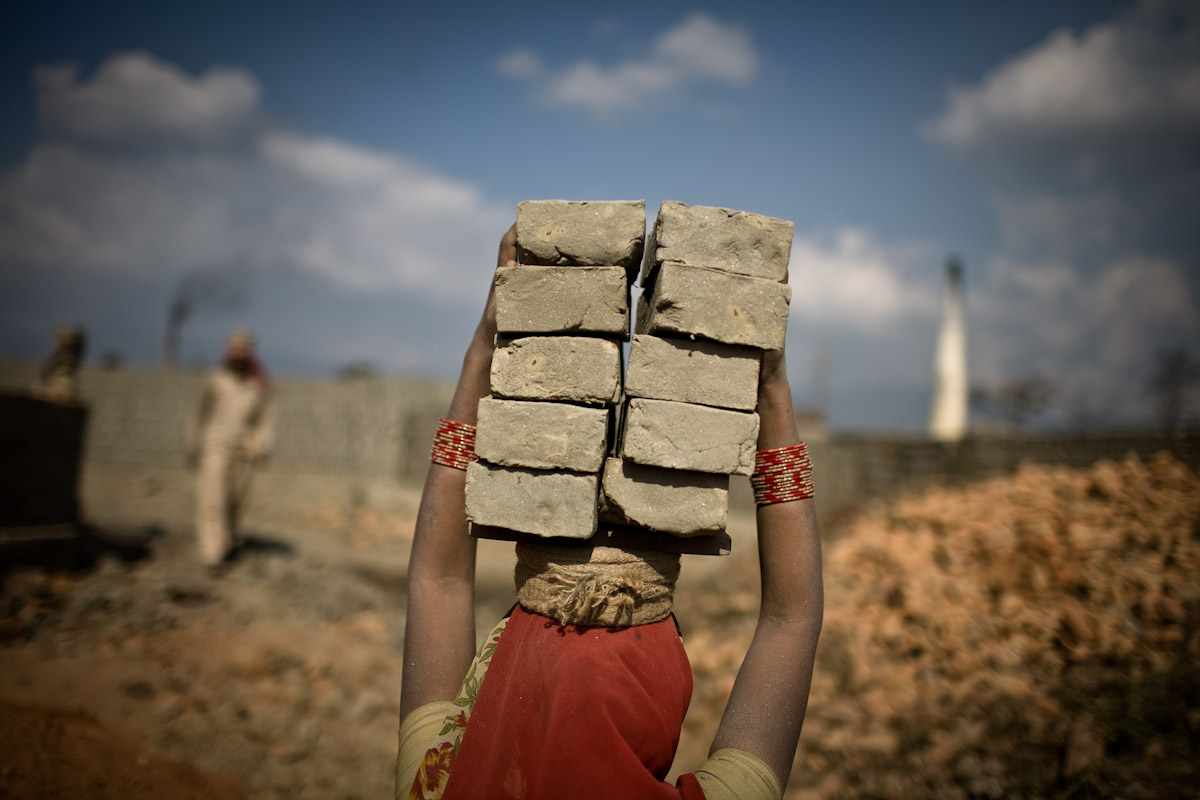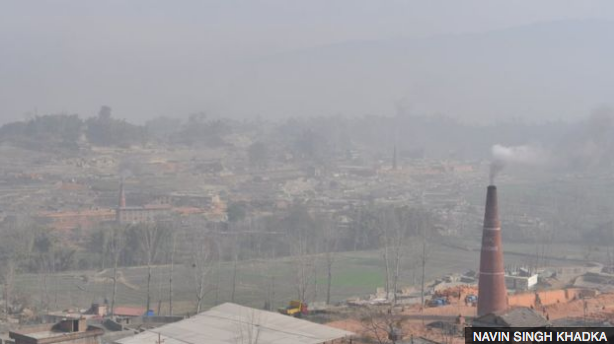Brick Kilns in Nepal: Building Back Better After the 2015 Earthquake

Introduction
During the spring of 2015, Nepal was rocked by numerous earthquakes that damaged more than 0.5 million buildings, 7000 schools and 1000 health facilities nationwide. As a result of the disaster some 3.2 million people lost their homes. The businesses that manufacture bricks were also heavily hit, impeding the rebuilding process. Approximately ninety-five percent of brick kilns in the Kathmandu Valley needed repairs.
Brick manufacturing is an energy intensive process. It is also one of the major sources of air pollution in South Asia. The brick firing process involves the burning of coal, wood and other biomass, and is responsible for 75% of sulphur dioxide emissions in the Kathmandu Valley. As a result of the numerous brick kilns in the area, air quality in the valley is at least 5 times worse than the World Health Organization guideline.
Rebuilding after the earthquake presented an opportunity to “build back better” through the incorporation of better technology when rebuilding destroyed kilns, which would directly reduce emissions and air pollution. It was also a chance to set standard kiln design guidelines and to introduce earthquake resistant chimneys. Before kiln owners began to rebuild, scientists, energy experts and engineers rallied together with the Federation of Nepal Brick Industries (FNBI) to design a new kiln for the Kathmandu Valley. The initiative carried out a feasibility study on rebuilding kilns and enhancing their efficiency, and developed a manual on improved brick kiln design that would ultimately contribute to the reduction of black carbon and other emissions.
The International Centre for Integrated Mountain Development (ICIMOD), together with the Federation of Nepal Brick Industries, MinErgy, GreenTech, and Climate and Health Research Network (CHeRN), undertook this project with financial support from the Climate and Clean Air Coalition (CCAC), in which Switzerland has been a partner since 2013 via the Swiss Agency for Development and Cooperation (SDC) and the Federal Office for the Environment (FOEN). ICIMOD is the regional partner for CCAC’s Brick Kiln Initiative.
This article borrows text from ICIMOD’s “Building back better brick kilns in Nepal” (2016) by Bidya Banmali Pradhan, CCAC’s “Bricks Success Story: Nepal Building Back Better” (2016) by the CCAC Secretariat, “Reviving brick industry” by Subasana Shrestha (2016) and from the film “Brick Kilns | Building Back Better” by ICIMOD.
The manual developed under this project is available to download from the right-hand column.
Methods and Tools
To ensure that kilns were rebuilt to be safer, more efficient and less polluting, local brick entrepreneurs, engineers, scientists and architects worked together, with advice from international experts, to design a building manual for induced draught and natural draught zig-zag kilns.
After many discussions and meetings with a team of country and regional experts ICIMOD, FNBI, MinErgy, GreenTech and the Climate and Health Research Network (CHeRN) drafted a manual for the rebuilding of structurally sound kilns in June 2015. The manual was presented during a multi-stakeholder inception meeting on ‘Policy and Advocacy for Reforming the Brick Sector‘ in July 2015 by FNBI, MinErgy and ICIMOD in Kathmandu, Nepal. The meeting brought together people from different fields—brick entrepreneurs, government officials from regulatory offices, non-profit, international, and intergovernmental agencies—to discuss existing policy and regulatory frameworks and identify gaps. It also aimed to understand available technology options and existing and future financing mechanisms that would be critical to developing more applicable and adaptable guidelines.
This meeting helped to generate ownership of and support for the effort, which in turn helped to reduce duplication and encourage others to use the manual in the rebuilding process. It also presented an opportunity for leaders to explain the concept of ‘building back better’ and emphasise that the infrastructure damaged by tremors should be reconstructed sustainably.
The resulting ‘Design Manual for Improved Fixed Chimney Zig-Zag Brick Kilns‘ was prepared and launched in September 2015.
The manual was the first of its kind in South Asia. Inside it kiln owners can find earthquake-resistant brick kiln designs and drawings that take energy efficiency, environmental concerns, and other social aspects into account. Constructing kilns using the new design helps ensure they are:
- structurally sound and earthquake resistant;
- energy efficient;
- less polluting compared to traditional brick kilns;
- more worker friendly; and that they
- produce higher quality bricks.
Outcomes and Impacts
The first five brick kilns constructed under the new guidelines baked their first batch of bricks in January 2016. As of December 2016 nine kilns had been rebuilt according to the new designs and other kilns had adopted the brick stacking and firing techniques. Emissions measured from these kilns showed a 60% decrease in particulate matter, and coal consumption was reduced by up to 40-50%. Due to improved air flow only ~70gm of coal is now needed to bake one brick whereas around ~90-100gm was required previously. Due to the efficient circulation of heat, the overal number of useable bricks produced has doubled, and the production of ‘A’ grade bricks has increased by 90%. Furthermore, workers at the brick kilns are experiencing less exposure to dust and pollution.
The total rebuilding cost of each of the nine kilns is estimated to be around $100,000, which the entrepreneurs involved in the project paid for themselves. The payback period for investing in rebuilding a kiln is expected to be less than two years. The kiln redesign has been a win-win situation. Entrepreneurs are benefiting from coal saving and better brick quality. The kilns are structurally sound, earthquake resistant, energy efficient and provide safer and healthier working conditions for workers.
The project was carried out in close collaboration with the Nepalese Government, which has invited CCAC partner ICIMOD to be part of a committee to revise the brick kiln emission standard. The Nepalese Department of Industry has since issued a notice that all brick kilns should be structurally safe and earthquake resistant. Furthermore, as news has spread about the benefits of the new design described in the manual – that it reduces coal and improves brick quality – there has been a significant increase in interest in adopting the new design from other entrepreneurs who are rebuilding kilns.

Related Projects
- Energy Efficiency Program for Brick Producers in Latin America to mitigate Climate Change (EELA): This information network for brick producers serves to support the exchange of knowledge and experiences between experts and brick producers in Latin America, Asia and Africa, including pictures, studies, speeches or just news. Visit the EELA network: http://www.redladrilleras.net/index.php
- The Energy Efficient Clay Brick project, South Africa (EECB): The EECB, through theClay Brick Association (CBA), expands awareness, knowledge and support for clay brick masonry in South Africa. It provides an extensive library of fact sheets and in-depth articles for property owners and developers, architects and builders. It also provides convenient map-based and city-based searches for buyers and quantity surveyors to find clay brick suppliers near their construction site. The Association is supported by SDC, as part of the Vertical Shaft Brick Kiln (VSBK) Programme, and Swisscontact, as part of their Energy efficient brick production in South Africa project. This work builds on the Vertical Shaft Brick Kiln (VSBK) Programme in Nepal and India, and has yielded the Green Brick Making Manual. A spin-off of this project has lead to the development of Recirculation Vertical Shaft Brick Kilns (RVSBK), in collaboration with Rowe Group. Visit the CBA: www.claybrick.org
Acknowledgements for the film “Brick Kilns | Building Back Better”
- Editor & Videographer: Susan Hale Thomas
- Narration: Prakash Bhave
- Script: Prakash Bhave & Susan Hale Thomas
- Production assistants: Bidya Banmali Pradhan & Amy Sellmyer
Special thanks to:
Mahendra Chitrakar (President, FNBI), Ram Kaji Awale (RK Bricks) and Raj Kumar Lakhemaru (Swet Bhairab Brick), and MinErgy, FNBI, CHeRN, Climate and Clean Air Coalition and the Norwegian Ministry of Foreign Affairs.
This work was partially supported by core funds of ICIMOD contributed by the governments of: Afghanistan, Australia, Austria, Bangladesh, Bhutan, China, India, Myanmar, Nepal, Norway, Pakistan, Switzerland and the United Kingdom.
Future steps
Nepal’s Clean Brick Initiative has been consolidated by the signing of an accountable grant arrangement between the Department for International Development (DFID), and ICIMOD. Per the arrangement, the five year project will be operational from November 2016 to June 2021, and will concentrate on the modification, mechanization and upgrading of technology for cleaner brick production in Nepal. Find out more here.
Related resources
- Read the BBC report "Nepal brick kilns rebuilt after quake become cleaner" by Navin Singh Khadka
- Read more about SDC's activities in Nepal, including a vocational education and training fund for disadvantaged people
- Read more about Switzerland's activities within the Climate and Clean Air Coalition
- Read the CACC news story "Bricks Success Story: Nepal Building Back Better"
- Read the ICIMOD factsheet "Building back better brick kilns in Nepal"
- Read the news story by Subasana Shrestha "Reviving brick industry" (ICIMOD, 16 Apr 2016)
- Read more about the damage caused by the 2015 Earthquake and CCAC's support for the brick industry in Nepal
- Read about the launch of the design manual to support the construction of stronger and cleaner brick kilns (ICIMOD)
(0) Comments
There is no content